Nursecate
On this page, you find all documents, package deals, and flashcards offered by seller NURSECATE.
- 537
- 0
- 0
Community
- Followers
- Following
537 items

NURS 6501N Week 2 Quiz (40 out of 40)
Content • Question 1 1 out of 1 points A 3-year-old is making play cakes in a sandbox and is eating the play cakes. The sand was also being used by cats as a litter box and was contaminated with toxoplasmosis. Which of the following would most likely also be present? Selected Answer: a. Granuloma formation • Question 2 1 out of 1 points A 30-year-old female is diagnosed with cancer. Testing reveals that the cancer cells have spread to local lymph nodes. A...
- Exam (elaborations)
- • 11 pages •
Content • Question 1 1 out of 1 points A 3-year-old is making play cakes in a sandbox and is eating the play cakes. The sand was also being used by cats as a litter box and was contaminated with toxoplasmosis. Which of the following would most likely also be present? Selected Answer: a. Granuloma formation • Question 2 1 out of 1 points A 30-year-old female is diagnosed with cancer. Testing reveals that the cancer cells have spread to local lymph nodes. A...
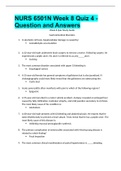
NURS 6501N Week 8 Quiz 4 - Question and Answers
1. In alcoholic cirrhosis, hepatocellular damage is caused by: • Acetaldehyde accumulation 2. A 22-year-old male underwent brain surgery to remove a tumor. Following surgery, he experienced a peptic ulcer. His ulcer is referred to as a(n)_____ulcer. • Cushing 3. The most common disorder associated with upper GI bleeding is: • Esophageal varices 4. A 55-year-old female has general symptoms of gallstones but is also jaundiced. IV cholangiography could most likely reveal that the ...
- Exam (elaborations)
- • 4 pages •
1. In alcoholic cirrhosis, hepatocellular damage is caused by: • Acetaldehyde accumulation 2. A 22-year-old male underwent brain surgery to remove a tumor. Following surgery, he experienced a peptic ulcer. His ulcer is referred to as a(n)_____ulcer. • Cushing 3. The most common disorder associated with upper GI bleeding is: • Esophageal varices 4. A 55-year-old female has general symptoms of gallstones but is also jaundiced. IV cholangiography could most likely reveal that the ...
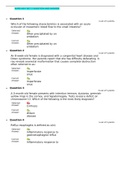
NURS 6501 SET 2 QUESTION AND ANSWER
• Question 1 1 out of 1 points Which of the following characteristics is associated with an acute occlusion of mesenteric blood flow to the small intestine? Selected Answer: a. Often precipitated by an embolism Correct Answer: a. Often precipitated by an embolism • Question 2 1 out of 1 points An 8-week-old female is diagnosed with a congenital heart disease and Down syndrome. Her parents report that she has difficulty defecating. X-ray reveals anorectal malform...
- Exam (elaborations)
- • 9 pages •
• Question 1 1 out of 1 points Which of the following characteristics is associated with an acute occlusion of mesenteric blood flow to the small intestine? Selected Answer: a. Often precipitated by an embolism Correct Answer: a. Often precipitated by an embolism • Question 2 1 out of 1 points An 8-week-old female is diagnosed with a congenital heart disease and Down syndrome. Her parents report that she has difficulty defecating. X-ray reveals anorectal malform...
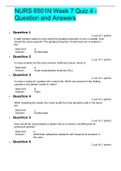
NURS 6501N Week 7 Quiz 4 - Question and Answers
• Question 1 1 out of 1 points A staff member wants to know where the greatest proportion of iron is located. How should the nurse respond? The greatest proportion of total body iron is located in the: Selected Answer: a. Erythrocytes • Question 2 1 out of 1 points A nurse monitors for the most common childhood cancer, which is: Selected Answer: a. Acute lymphoblastic leukemia (ALL) • Question 3 1 out of 1 points A nurse is caring for a patient w...
- Exam (elaborations)
- • 7 pages •
• Question 1 1 out of 1 points A staff member wants to know where the greatest proportion of iron is located. How should the nurse respond? The greatest proportion of total body iron is located in the: Selected Answer: a. Erythrocytes • Question 2 1 out of 1 points A nurse monitors for the most common childhood cancer, which is: Selected Answer: a. Acute lymphoblastic leukemia (ALL) • Question 3 1 out of 1 points A nurse is caring for a patient w...

NURS 6501N Week 1 Quiz QUESTION AND ANSWER
Question 1 of 40 A 55-year-old male with a 30-year history of smoking is examined for respiratory disturbance. Examination of his airway (bronchial) reveals that stratified squamous epithelial cells have replaced the normal columnar ciliated cells. This type of cellular adaptation is called anaplasia. hyperplasia. metaplasia. dysplasia. 2 of 40 Hypernatremia can result from which of the following? Decreased aldosterone secretion Decreased antidiuretic hormone secretion ...
- Exam (elaborations)
- • 12 pages •
Question 1 of 40 A 55-year-old male with a 30-year history of smoking is examined for respiratory disturbance. Examination of his airway (bronchial) reveals that stratified squamous epithelial cells have replaced the normal columnar ciliated cells. This type of cellular adaptation is called anaplasia. hyperplasia. metaplasia. dysplasia. 2 of 40 Hypernatremia can result from which of the following? Decreased aldosterone secretion Decreased antidiuretic hormone secretion ...
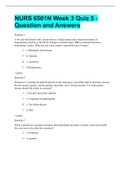
NURS 6501N Week 3 Quiz 5 - Question and Answers
Question 1 A 60-year-old female with a recent history of head trauma and a long-term history of hypertension presents to the ER for changes in mental status. MRI reveals that she had a hemorrhagic stroke. What does the nurse suspect caused this type of stroke? a. Rheumatic heart disease b. Thrombi c. Aneurysm d. Hypotension 1 points Question 2 Parents of a 3-month-old infant bring him to the emergency room (ER) after he has had a seizure. He has muscle rigidity, and the ...
- Exam (elaborations)
- • 9 pages •
Question 1 A 60-year-old female with a recent history of head trauma and a long-term history of hypertension presents to the ER for changes in mental status. MRI reveals that she had a hemorrhagic stroke. What does the nurse suspect caused this type of stroke? a. Rheumatic heart disease b. Thrombi c. Aneurysm d. Hypotension 1 points Question 2 Parents of a 3-month-old infant bring him to the emergency room (ER) after he has had a seizure. He has muscle rigidity, and the ...
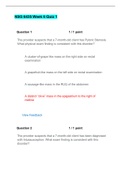
NSG 6435 Week 6 Quiz 1
Question 1 1 / 1 point The provider suspects that a 7-month-old client has Pyloric Stenosis. What physical exam finding is consistent with this disorder? A cluster-of-grape like mass on the right side on rectal examination A grapefruit-like mass on the left side on rectal examination A sausage-like mass in the RUQ of the abdomen A distinct “olive” mass in the epigastrium to the right of midline View Feedback Question 2 1 / 1 point
- Exam (elaborations)
- • 8 pages •
Question 1 1 / 1 point The provider suspects that a 7-month-old client has Pyloric Stenosis. What physical exam finding is consistent with this disorder? A cluster-of-grape like mass on the right side on rectal examination A grapefruit-like mass on the left side on rectal examination A sausage-like mass in the RUQ of the abdomen A distinct “olive” mass in the epigastrium to the right of midline View Feedback Question 2 1 / 1 point
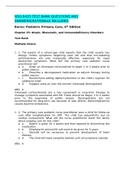
NSG 6435 TEST BANK QUESTIONS AND ANSWERS(RATIONALE INCLUDED
Burns: Pediatric Primary Care, 6th Edition Chapter 25: Atopic, Rheumatic, and Immunodeficiency Disorders Test Bank Multiple Choice 1. 1. The parent of a school-age child reports that the child usually has allergic rhinitis symptoms beginning each fall and that non-sedating antihistamines are only marginally effective, especially for nasal obstruction symptoms. What will the primary care pediatric nurse practitioner do? a. a. Order an intranasal corticosteroid to begin 1 to 2 weeks p...
- Exam (elaborations)
- • 60 pages •
Burns: Pediatric Primary Care, 6th Edition Chapter 25: Atopic, Rheumatic, and Immunodeficiency Disorders Test Bank Multiple Choice 1. 1. The parent of a school-age child reports that the child usually has allergic rhinitis symptoms beginning each fall and that non-sedating antihistamines are only marginally effective, especially for nasal obstruction symptoms. What will the primary care pediatric nurse practitioner do? a. a. Order an intranasal corticosteroid to begin 1 to 2 weeks p...
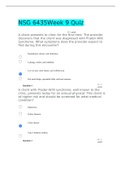
NSG 6435Week 9 Quiz
A client presents to clinic for the first time. The provider discovers that the client was diagnosed with Prader-Willi Syndrome. What symptoms does the provider expect to find during this encounter? Hyperphasia, obesity, and strabismus Lethargy, stridor, and irritability Low-set ears, short stature, and webbed neck Flat nasal bridge, epicanthal folds, and heart murmur Question 2 0 / 1 point A client with Prader-Willi syndrome, well-known to the clinic, presents today for...
- Exam (elaborations)
- • 5 pages •
A client presents to clinic for the first time. The provider discovers that the client was diagnosed with Prader-Willi Syndrome. What symptoms does the provider expect to find during this encounter? Hyperphasia, obesity, and strabismus Lethargy, stridor, and irritability Low-set ears, short stature, and webbed neck Flat nasal bridge, epicanthal folds, and heart murmur Question 2 0 / 1 point A client with Prader-Willi syndrome, well-known to the clinic, presents today for...
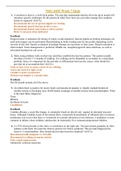
NSG 6435 Week 7 Quiz
1. A newborn is born w/ a cleft lip & palate. The provider understands that the slit in the lip & mouth will introduce specific challenges for the parents & child. How best can a provider manage this condition before its repaired? (SATA) Recommend the use of special nipples for feeding Recommend speech therapy in later years. Recommend dental restoration as often needed. Refer to surgeon when indicated Feedback Surgical repair is indicated, the timing of which is individualized. Special ...
- Exam (elaborations)
- • 3 pages •
1. A newborn is born w/ a cleft lip & palate. The provider understands that the slit in the lip & mouth will introduce specific challenges for the parents & child. How best can a provider manage this condition before its repaired? (SATA) Recommend the use of special nipples for feeding Recommend speech therapy in later years. Recommend dental restoration as often needed. Refer to surgeon when indicated Feedback Surgical repair is indicated, the timing of which is individualized. Special ...
